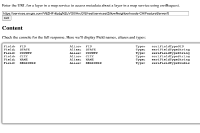 Hide Table of Contents
Hide Table of Contents
 Analysis
Analysis
 Dynamic Layers
Dynamic Layers
 Editing
Editing
 Feature Layers
Feature Layers
 Feature Table
Feature Table
 Graphics
Graphics
 Map
Map
 Mobile
Mobile
 Online and Portal
Online and Portal
 Popups and Info Windows
Popups and Info Windows
 Query and Select
Query and Select
 Renderers, Symbols, Visualization
Renderers, Symbols, Visualization
 Search
Search

Request layer info
Explore in the sandbox
Open in CodePen
View live sample
Description
esri/request can be used to get info about any object in the ArcGIS Server services directory. In this sample, esriRequest is used to get metadata about a layer in a map service. All of the info for the layer is printed to the console as a string and info about the layer's fields are printed to a textarea.The technique used here could also be used to get info about a map service or any other service published to the services directory.
Code
<!DOCTYPE html>
<html>
<head>
<title>Get ArcGIS Server Map Service Layer Field Names</title>
<meta http-equiv="Content-Type" content="text/html; charset=utf-8">
<link rel="stylesheet" href="https://js.arcgis.com/3.46/esri/css/esri.css">
<style>
body{
font-family: "Arial Unicode MS, Arial, sans-serif";
}
#content {
width: 800px; height: 350px; padding: 5px; overflow: auto;
border: solid 2px #AAAAAA; background-color: #FFFFFF;
border-radius: 5px;
-moz-box-shadow: 0 0 0.5em black; -webkit-box-shadow: 0 0 0.5em black; -o-box-shadow: 0 0 0.5em black; box-shadow: 0 0 0.5em black;
}
.failure { color: red; }
#status { font-size: 12px; }
</style>
<script src="https://js.arcgis.com/3.46/"></script>
<script>
require(["dojo/dom", "dojo/on", "dojo/dom-class", "dojo/_base/json", "dojo/_base/array", "dojo/string", "esri/request", "dojo/domReady!"], function(dom, on, domClass, dojoJson, array, dojoString, esriRequest) {
dom.byId("url").value = "https://services.arcgis.com/V6ZHFr6zdgNZuVG0/ArcGIS/rest/services/ZillowNeighborhoods-CA/FeatureServer/0";
dom.byId("content").value = "";
//handle the Go button's click event
on(dom.byId("submitRequest"), "click", getContent);
function getContent(){
var contentDiv = dom.byId("content");
contentDiv.value = "";
domClass.remove(contentDiv, "failure");
dom.byId("status").innerHTML = "Downloading...";
//get the url
var url = dom.byId("url").value;
if(url.length === 0){
alert("Please enter a URL");
return;
}
var requestHandle = esriRequest({
"url": url,
"content": {
"f": "json"
},
"callbackParamName": "callback"
});
requestHandle.then(requestSucceeded, requestFailed);
}
function requestSucceeded(response, io){
var fieldInfo, pad;
pad = dojoString.pad;
//toJson converts the given JavaScript object
//and its properties and values into simple text
dojoJson.toJsonIndentStr = " ";
console.log("response as text:\n", dojoJson.toJson(response, true));
dom.byId("status").innerHTML = "";
//show field names and aliases
if ( response.hasOwnProperty("fields") ) {
console.log("got some fields");
fieldInfo = array.map(response.fields, function(f) {
return pad("Field:", 8, " ", true) + pad(f.name, 25, " ", true) +
pad("Alias:", 8, " ", true) + pad(f.alias, 25, " ", true) +
pad("Type:", 8, " ", true) + pad(f.type, 25, " ", true);
});
dom.byId("content").value = fieldInfo.join("\n");
} else {
dom.byId("content").value = "No field info found. Please double-check the URL.";
}
}
function requestFailed(error, io){
domClass.add(dom.byId("content"), "failure");
dojoJson.toJsonIndentStr = " ";
dom.byId("content").value = dojoJson.toJson(error, true);
}
});
</script>
</head>
<body>
<p>Enter the URL for a layer in a map service to access metadata about a layer in a map service using esriRequest.</p>
<p>
<input type="text" id="url" size="105"/>
<input id="submitRequest" type="button" value="GO" />
<span id="status"></span>
</p>
<h2>Content</h2>
<p>Check the console for the full response. Here we'll display Field names, aliases and types:</p>
<textarea id="content"></textarea>
</body>
</html>